Extended breed standard
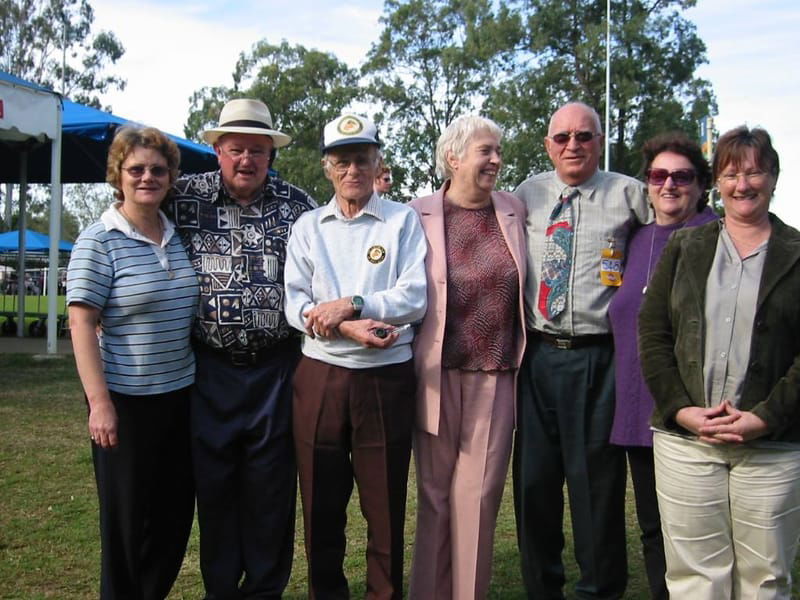
General Appearance
Well balanced, smooth coated, medium size with elegant and flowing outlines but strong and well muscled.
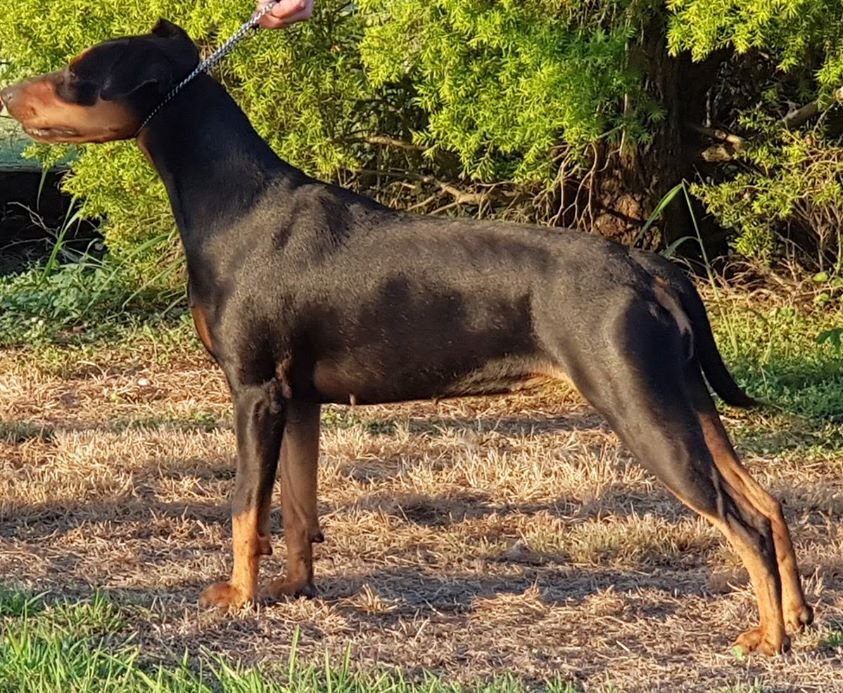 | 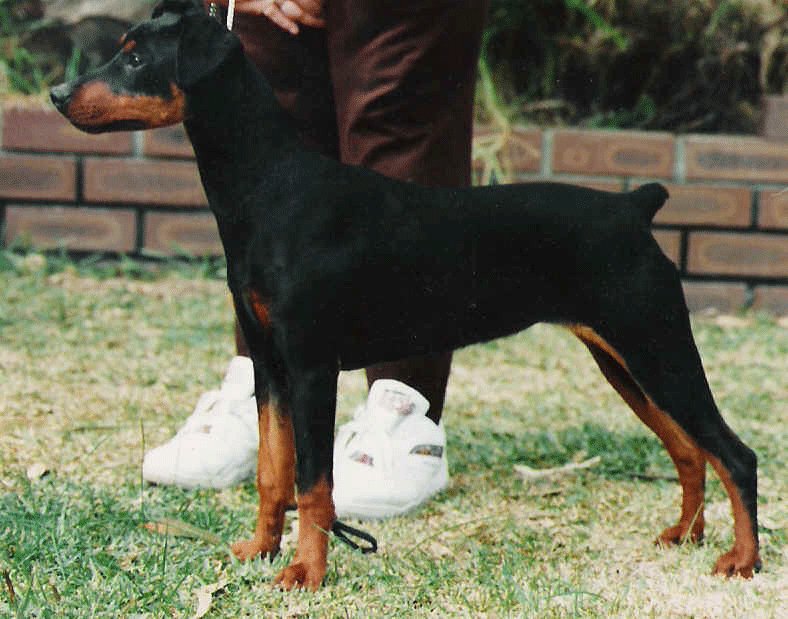 | 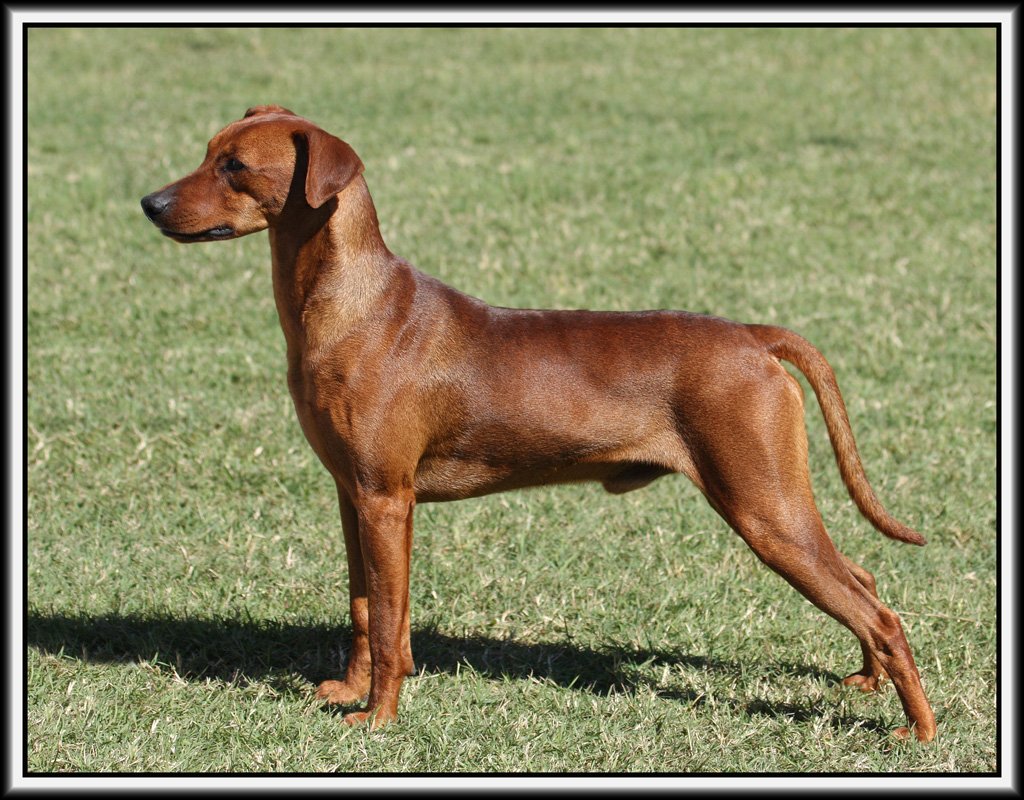 |
The extension of the breed standard.
Comments
The German Pinscher and the standard Schnauzer were the same breed just the smooth and rough coated pups in the litter. It was the rough coats that became popular and the smooth coated dogs almost became extinct during WWII. The breed in Australia was originally thought it should have been placed in group 2 as they are more terrier in type but the fear was they would then be expected to move like one, which is not correct.
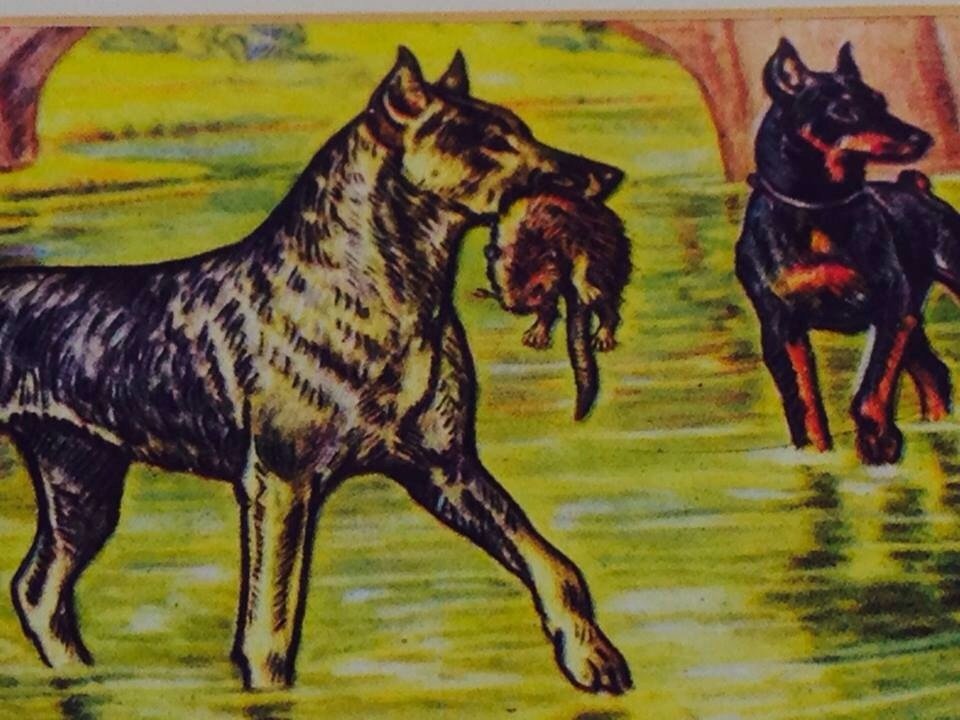 | 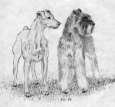 | 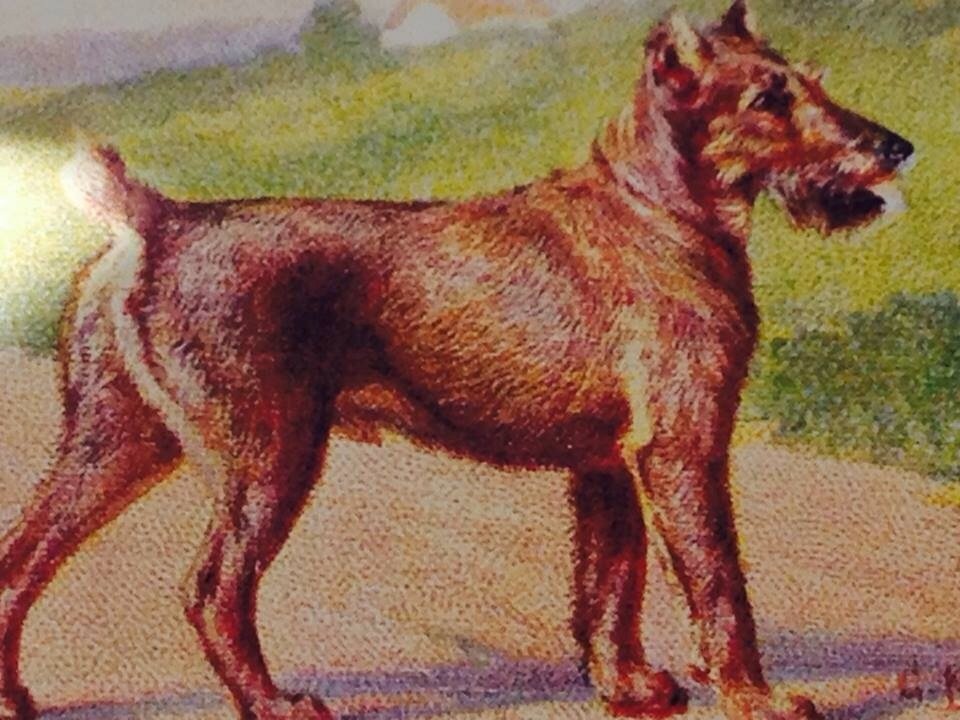 |
Comments - history
Although the German Pinscher is often compared to the standard Schnauzer it is closest to the Giant Schnauzer by breed standard. The GP and the Schnauzer were originally born in the same litters as the rough and smooth coated varieties of the breed. Both are a ratting breed with strong prey drive.
Comments - Temperament
High-spirited and self-possessed.
This breed is a hunting and guarding breed., therefore it has a strong prey drive and alertness to strangers. It is often called an arrogant breed, due to its non interest in strangers as an adult. Yet is know as a clwn for its owners. These are extremely loyal dogs and very protective of its family. It is meant to be breed that cannot be bribed by strangers.
The breed is family friendly with a strong protective instinct. GP's are also possessive with anything they deem theirs including the home territory and family, toys , chairs, trolleys and especially food.
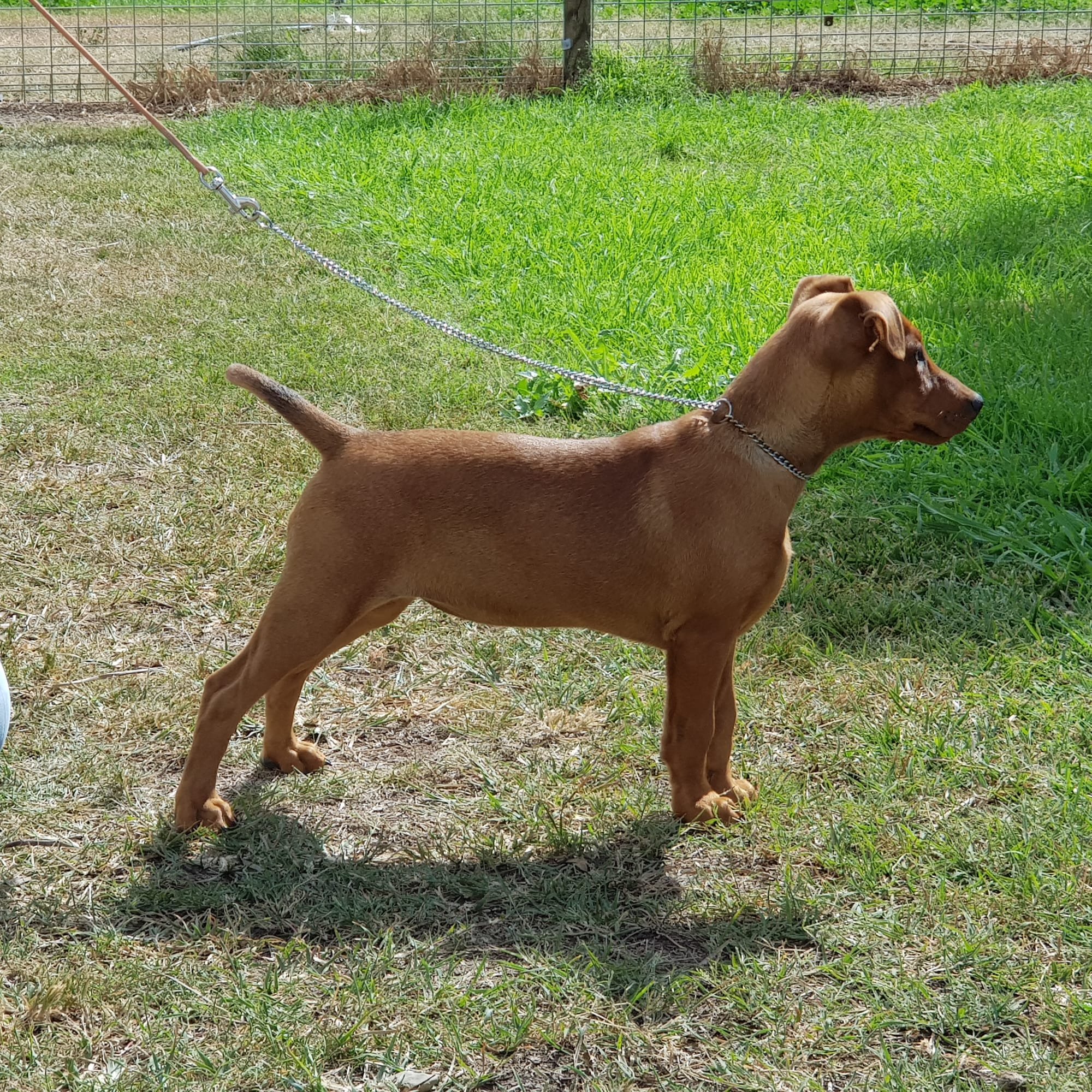 | 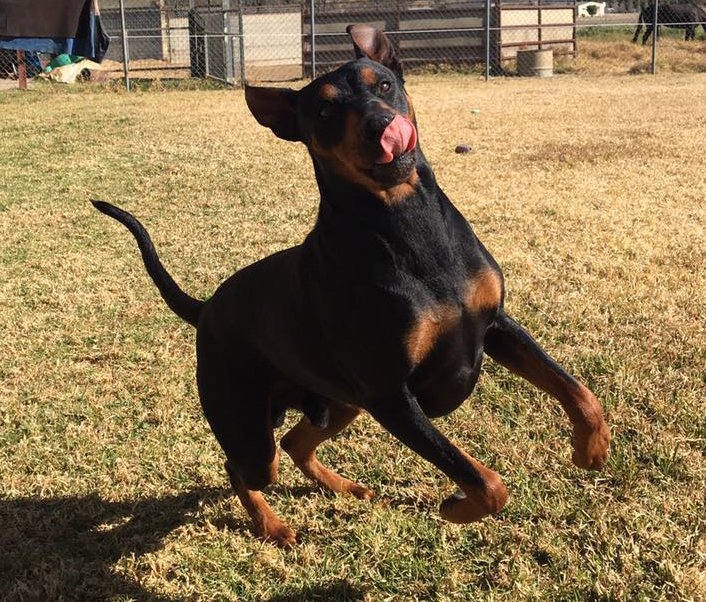 | 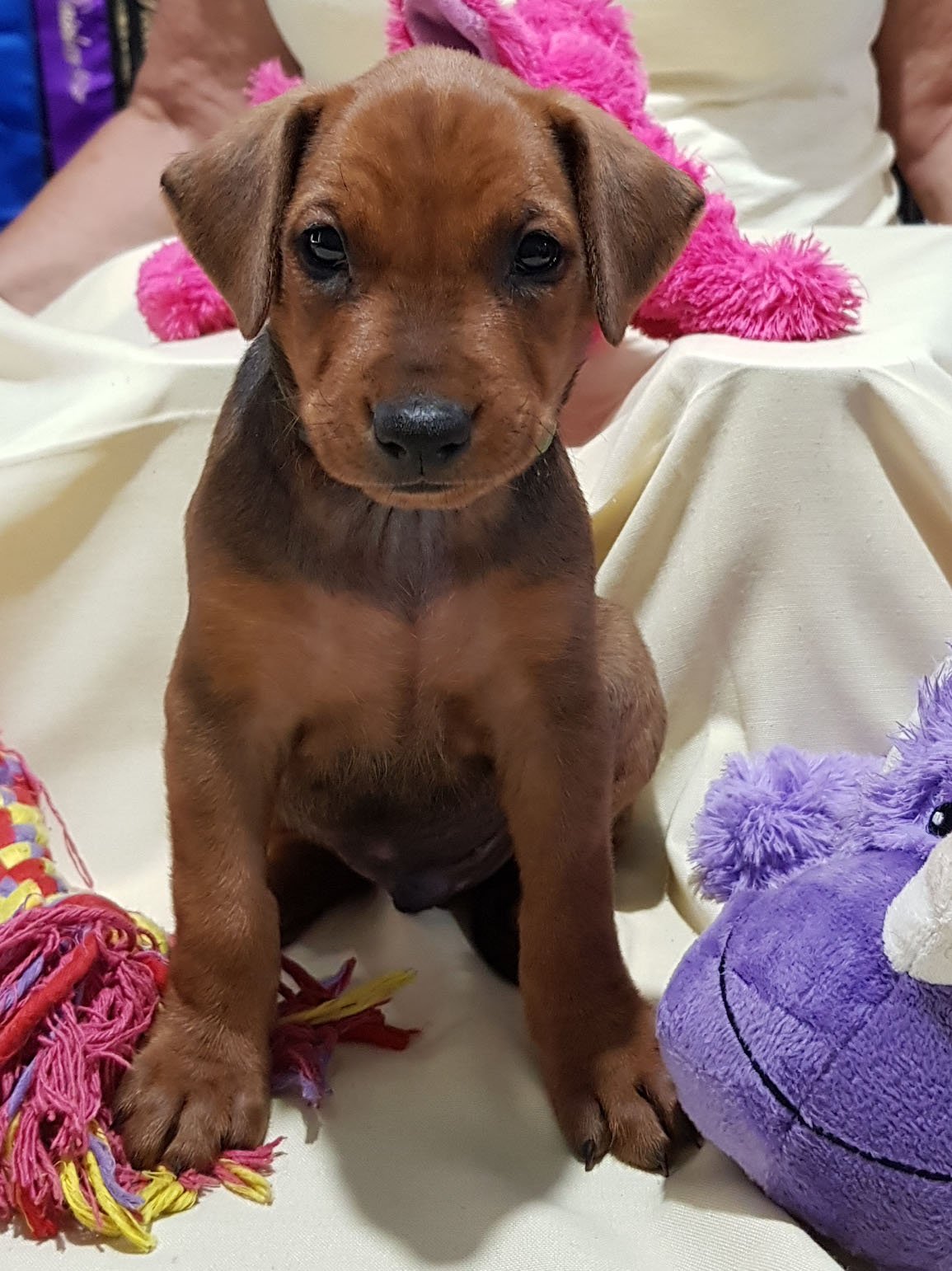 |
Comments - Head
Head type is similar to the shaved Schnauzer. The head is an elongated BLUNT WEDGE shape, but not too long as in the Dobermann who has a long elongated head (modern). A slightly shorter muzzle is common and correct in this breed. Full deep muzzle and strong under jaw is required to perform this breeds applied work. It is expected that the fill under the eye lacking contributes to the snipey muzzle as often seen and a bit of too much cheekiness is common. It is commonly believed the muzzle should be well filled under the eye. Snipiness is commonly seen in the GP. NEVER should it be the same as the Dobermann head. It is a shorter head than the Dobermann and most similarly to the giant Schnauzer.
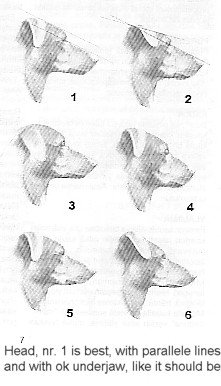 | 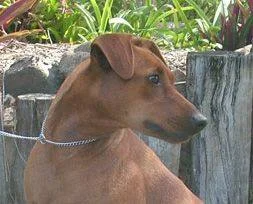 | 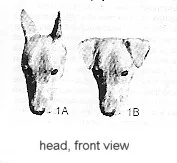 | 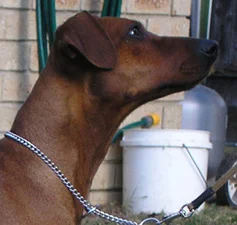 |
Comments - Eyes
The eye colour in the Stag Red, Blue and Fawns are accepted if a lighter colour than the dark eye expected in the black in the standard and correspond to the pigments of the coat colours. The reds of all shades should have a dark pigment - never light or missing. The GP must have an oval eye, NEVER a round eye. The darker eye and pigment is sort after and is correct.
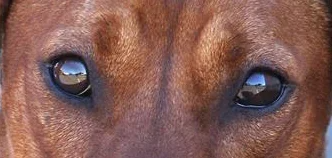 | 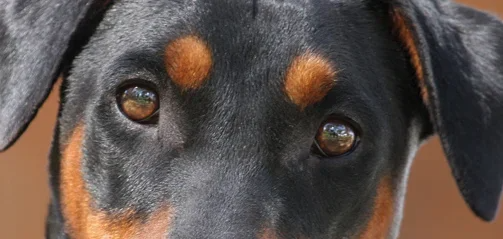 |
Comments - Mouth
The mouth of the GP was once accepted to have the Pinscher or Level bite. This appears occasionally and is now a fault in the breed. The true scissor bite is the only bite accepted. German Pinschers are best mouthed by their owners, but will tolerate a judges handling if not roughly done.
Comments- Ears
Ear sets should not be erect like the Miniature Pinscher, but this is an issue in some lines of GP's due to the introduction of the Min Pin when Werner Jung the original founder used oversized Min Pins to revitalise the German Pinscher breed in 1957, since it was almost extinct with only 2 females remaining in East Germany at that time. Very high set ears are common and acceptable providing they do not stand erect and lay correctly as in the bitch below.
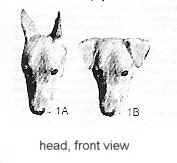 | 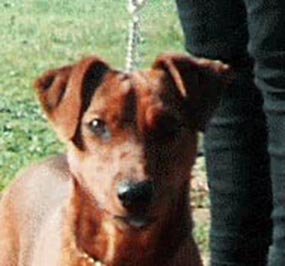 | 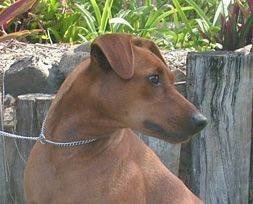 |
Comments - Neck
The neck of the German Pinscher is called to be elegant but strong. Elegant in this sense is not giraffe like or refined- so fine creating a weak thin neck. These dogs are hunters and must have enough strength to bite and shake a good sized prey or even larger animals it catches.
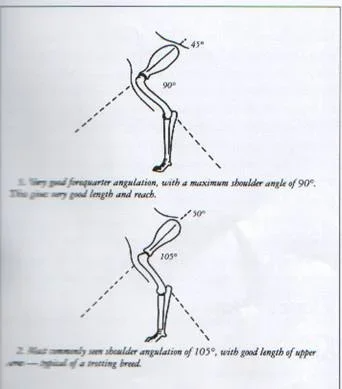 | 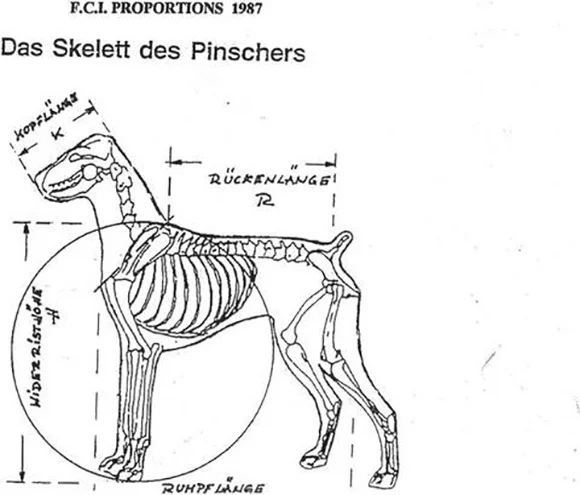 | 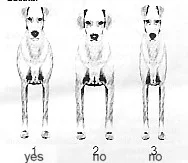 | 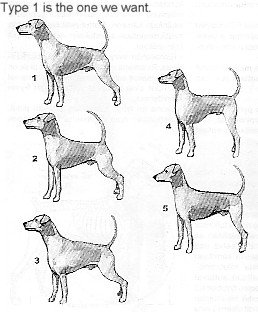 |
Comments - Angulation
The angulation in the GP has been debated many times. The FCI standard says 95 to 100 degrees. I believe the FCI to be the correct one.
The USA breed Standard says 90 degrees.
The UK does not have details on the degree.
Comments - Size
Size in the GP is important with the breed getting bigger and bigger. Often 3 inches over sized.
The breed has no difference between dogs and bitches.The standard in Australia is 17 inches - 19 inches. The breed has an accepted addition to height allowance of 1 inch. All other breed standards in the world are 17 inches to 20 inches.
The breed also does not need to go under the 17 inch standard. Under the standard to more undesirable than over.
Comments - Spring of Rib
Spring of rib is often confused in this breed. It is NOT well sprung but a flat spring of rib. NEVER slab sided ribs, as often seen in other breeds. The rib has good spring going into the flat rib as its comes over the side of the dog and down into the brisket area. A slab sided dog would have to have a very narrow width of body to accommodate a slab sided rib spring.
Comments - Thighs
Thighs should be strong with elongated muscle like an athlete with good width of both upper and lower thigh with moderate turn of stifle. The lower thigh is slightly longer than the upper thigh but not so long as to have the hocks too far back behind the hunches When stacked with hocks straight to the ground.
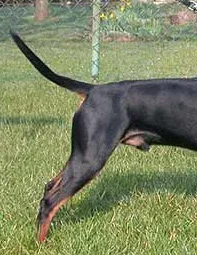 | 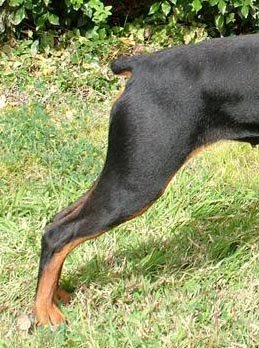 | 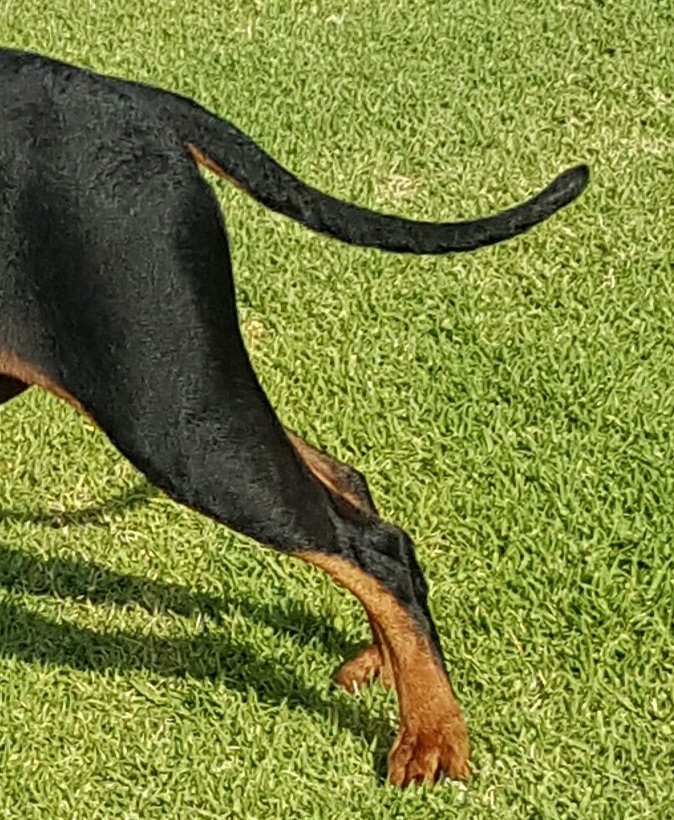 |
Feet
Front feet are cat like feet. Small and tight with the rear slightly longer but not hare footed.
 good cat like feet | 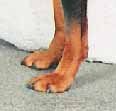 Flat feet |
Comments - Tails
The tail is a sabre tail - meaning a nice curve from correct set on of tail without an obvious curl nor a spitz type tail curling over the back or touching the back.
The tail is high set but never gay tail or hooked in the docked dog or the natural tailed dog.
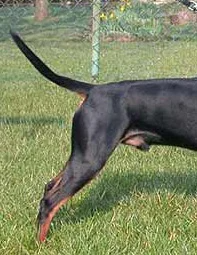 | 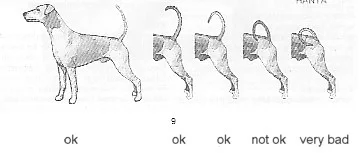 | 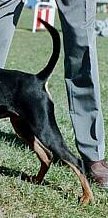 |
Comments - Gaits and head position
The German Pinscher gaits with its head in the almost level position if built correctly while on the move. See strong topline held on the move in the gait.
Hackney movement is a highly serious fault and a dog exhibiting this movement is incorrect. It is a disqualifying fault in the FCI breed standard.
The rotary action is only in the UK breed standard and is a strong driving movement out the back of the dog with a higher lift when rotating its hock back under the body hitting the ground with strong power for the rear drive in a dog while on the chase after rabbits etc. and is a ground covering movement when at speed. The German Pinscher is a trotter while on the hunt. This enables a dog to go over long distances while hunting.
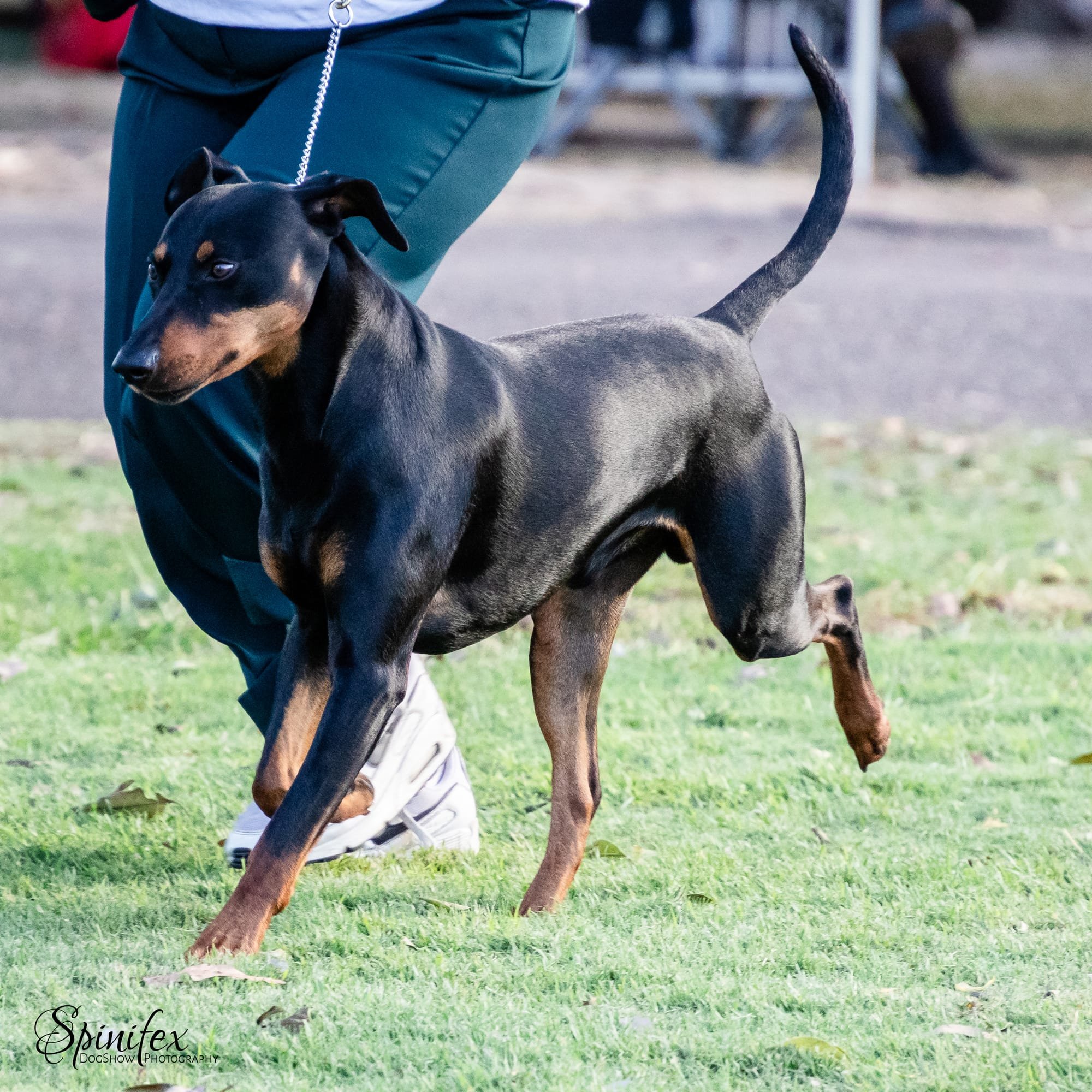 | 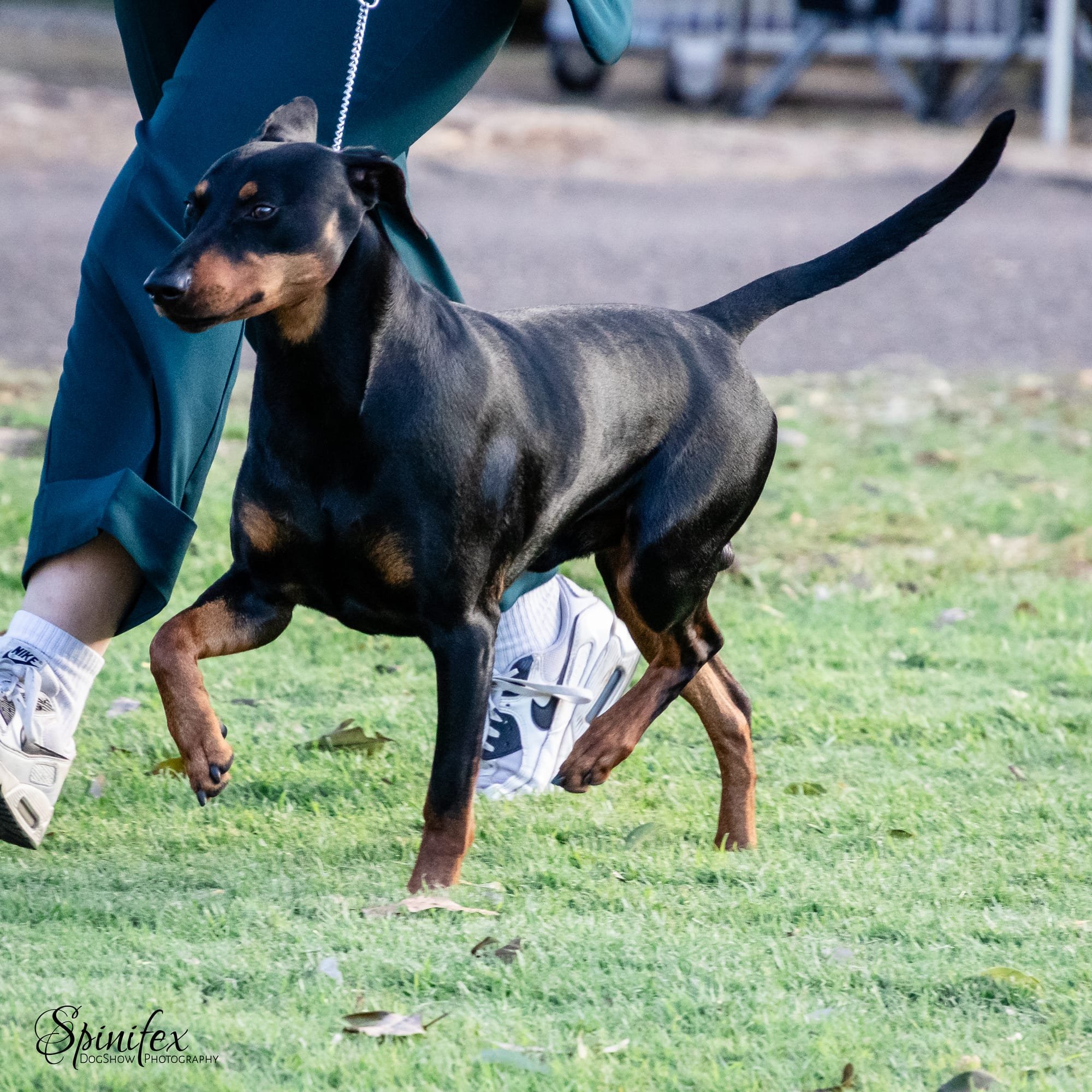 | 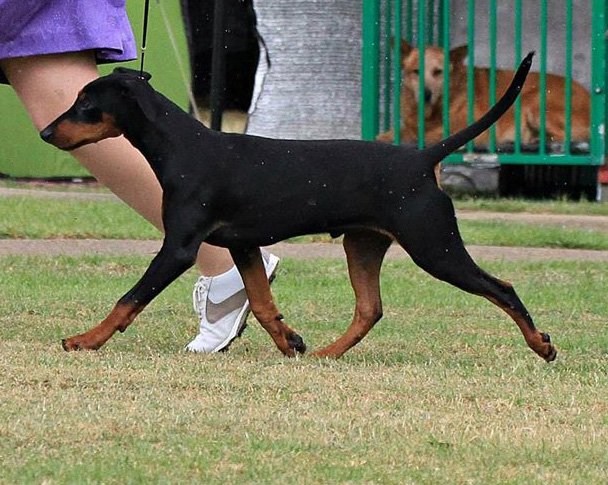 |
Comments - Colours
The German Pinscher has a variety of colours that are not included in this breed standard. The wild boar, the Red nosed red and the Chocolate.
The original colours where the black/reddish tan, Blue and Tan, Isabella, the Red to Stag red, the chocolate and tan, solid Black and the Salt and Pepper.
The stag red has black hairs throughout its red hairs but should not be overdone as to create a saddle appearance over the back as in picture below.
White is not acceptable.
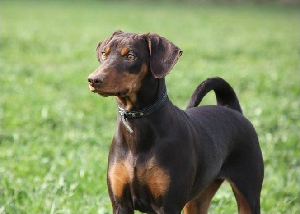 The chocolate GP an original colour. | 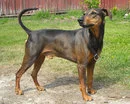 The boar colour is a recent addition to the breed. It is also unrecognised by the FCI. | 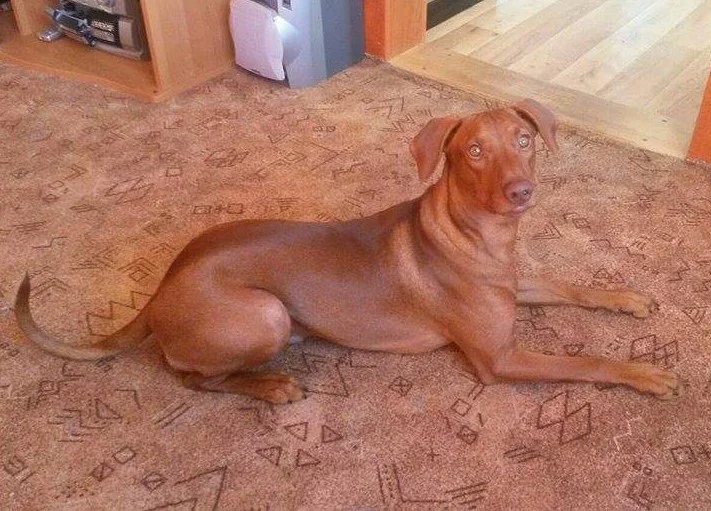 The red nose red colour. Also a more recent colour found in the breed. Not recognised by the FCI. |
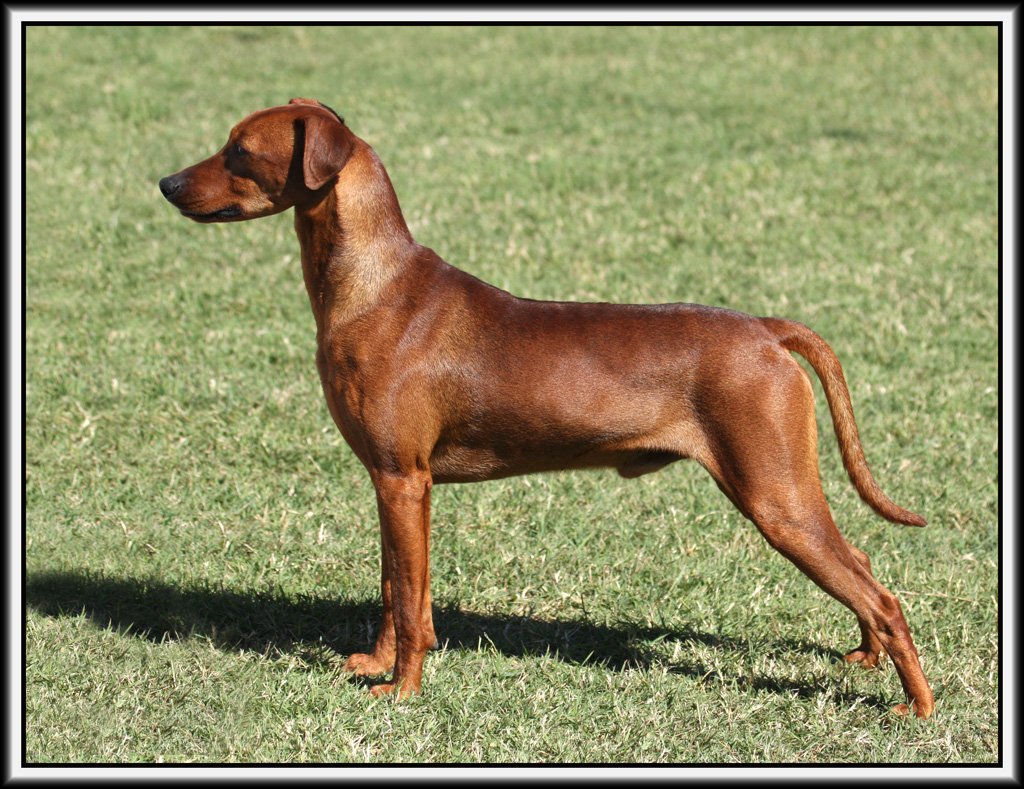 The red or stag red. | 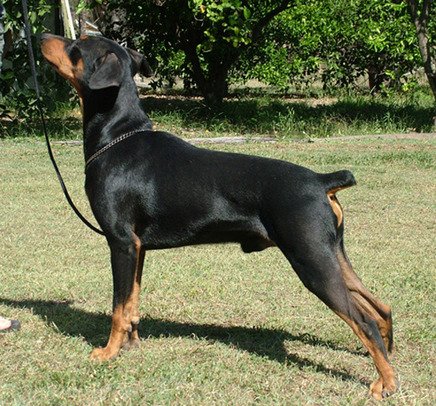 black and red | 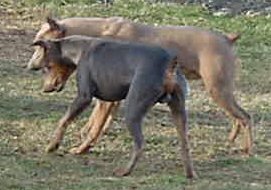 The blue and tan and the Isabella |
This red darker saddle over the back is not the ideal stag colour although accepted, it is not preferred but not a disqualifying fault.
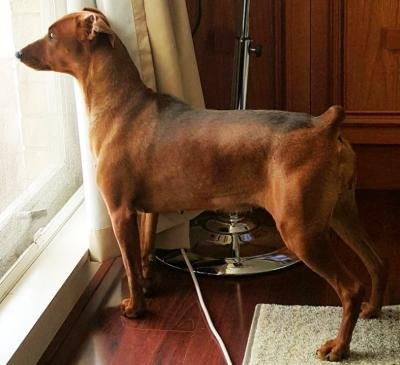
Comments - Size
The breed under the UK breed standard height 17 up to 19 inches. The other world standards are all at 17 - 20 inches both the Bitches and Dogs. Most breeders allow for this in their breeding program. There are dogs that are over sized by 2-3 inches. Most bitches are from 17 - 18 inches as an average. Most dogs are from 18 to 20 on average.
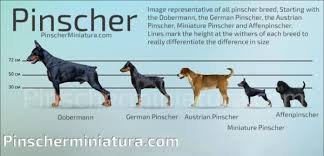 | 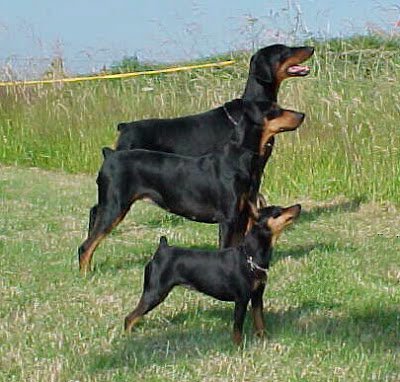 | 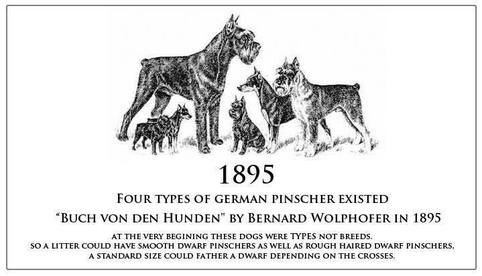 |
Note:
Male animals should have two apparently normal testicles fully descended into the scrotum.
*Note for prospective puppy buyers
Size – the Kennel Club Breed Standard is a guide and description of the ideal for the breed; the Size as described does not imply that a dog will match the measurements given (height or weight). A dog might be larger or smaller than the size measurements stated in the Breed Standard.
Optical illusion
The docked dogs will often appear to be a squarer/shorter dog until you are used to seeing the tail extended from the rear of the dog.
The GP tail is vulnerable to breakages and damage through wagging and hitting it on anything it is close too. Once of the reasons the breed was docked originally.
NOTE : To my knowledge all the photos used that are not my own, I have been given permission to use them in a breed lecture on GP's or on my website.


